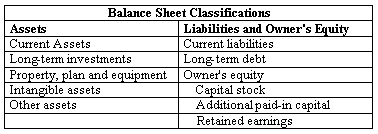Subject 1. Components and Format of the Balance Sheet
#analyst-notes #cfa-level-1 #financial-reporting-and-analysis #has-images #reading-26-understanding-balance-sheets
- Assets are the economic resources controlled by the company.
- Liabilities are the financial obligations that the company must fulfill in the future. Liabilities are typically fulfilled by payment of cash. They represent the source of financing provided to the company by the creditors.
- Equity ownership is the owner's investments and the total earnings retained from the commencement of the company. Equity represents the source of financing provided to the company by the owners.
The balance sheet provides users, such as creditors and investors, with information regarding the sources of finance available for projects and infrastructure. At the same time, it normally provides information about the future earnings capacity of a company's assets as well as an indication of cash flow implicit in the receivables and inventories.
The balance sheet has many limitations, especially relating to the measurement of assets and liabilities. The lack of timely recognition of liabilities and, sometimes, assets, coupled with historical costs as opposed to fair value accounting for all items on the balance sheet, implies that the financial analyst must make numerous adjustments to determine the economic net worth of the company.
The analyst must understand the components, structure, and format of the balance sheet in order to evaluate the liquidity, solvency, and overall financial position of a company.
Balance Sheet Format
Balance sheet accounts are classified so that similar items are grouped together to arrive at significant subtotals. Furthermore, the material is arranged so that important relationships are shown.
The table below indicates the general format of balance sheet presentation:

This format is referred to as the account format, which follows the pattern of the traditional general ledger accounts, with assets at the left and liabilities and equity at the right of a central dividing line. A report format balance sheet lists assets, liabilities, and equity in a single column.
Balance Sheet Components
Current Assets
These are cash and other assets expected to be converted into cash, sold, or consumed either in one year or in the operating cycle, whichever is longer. The operating cycle is the average time between the acquisition of materials and supplies and the realization of cash through sales of the product for which the materials and supplies were acquired. The cycle operates from cash through inventory, production, and receivables back to cash. Where there are several operating cycles within one year, the one-year period is used. If the operating cycle is more than one year, the longer period is used.
Long-Term Investments
Often referred to simply as investments, these are to be held for many years and are not acquired with the intention of disposing of them in the near future.
- Investments in securities such as bonds, common stock, or long-term notes that management does not intend to sell within one year.
- Investments in tangible fixed assets not currently used in operations, such as land held for speculation.
- Investments set aside in special funds, such as a sinking fund, pension fund, or plant expansion fund. The cash surrender value of life insurance is included here.
- Investments in non-consolidated subsidiaries or affiliated companies.
Property, Plant, and Equipment
These are properties of a durable nature used in the regular operations of the business. With the exception of land, most assets are either depreciable (such as a building) or consumable.
Intangible Assets
These lack physical substance and usually have a high degree of uncertainty concerning their future benefits. They include patents, copyrights, franchises, goodwill, trademarks, trade names, secret processes, and organization costs.
Other Assets
These vary widely in practice. Examples include deferred charges (long-term pre-paid expenses), non-current receivables, intangible assets, assets in special funds, and advances to subsidiaries.
Current Liabilities
These are obligations that are reasonably expected to be liquidated either through the use of current assets or the creation of other current liabilities within one year or within the operating cycle, whichever is longer.
The excess of total current assets over total current liabilities is referred to as working capital. It represents the net amount of a company's relatively liquid resources; that is, it is the liquid buffer, or margin of safety, available to meet the financial demands of the operating cycle.
Long-Term Liabilities
These are obligations that are not reasonably expected to be liquidated within the normal operating cycle but instead at some date beyond that time. Bonds payable, notes payable, deferred income taxes, lease obligations, and pension obligations are the most common long-term liabilities. Generally they are of three types:
- Obligations arising from specific financing situations, such as issuance of bonds, long-term lease obligations, and long-term notes payable.
- Obligations arising from the ordinary operations of the enterprise, such as pension obligations and deferred income tax liabilities.
- Obligations that are dependent upon the occurrence or non-occurrence of one or more future events to confirm the amount payable, or the payee, or the date payable, such as services or product warranties and other contingencies.
Owner's Equity
The complexity of capital stock agreements and the various restrictions on residual equity imposed by state corporation laws, liability agreements, and boards of directors make the owner's equity section one of the most difficult sections to prepare and understand. This section is usually divided into three parts:
- Capital stock: the par or stated value of the shares issued.
- Additional paid-in capital: the excess of amounts paid in over the par or stated value.
- Retained earnings: the corporation's undistributed earnings.